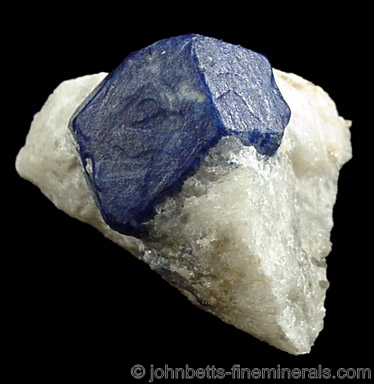The Mineral lazurite

Lazurite is famous for its gem form, Lapis Lazuli. Lapis Lazuli, casually called by its shortened name Lapis, is the gemstone form of Lazurite that is associated with white Calcite and sparkling Pyrite. The name Lazurite is derived from the term "Lazaward", which means heaven in Arabic, alluding to its blue color.
Lazurite occurs almost exclusively in massive form without any visible crystals. The exception is the historic occurrence of Afghanistan, where this mineral is famous and highly regarded for producing outstanding rich-blue crystals unlike any other minerals. These crystals, almost always perched in a white marble matrix, are highly sought out after by mineral collectors. When not used as gemstones, the non-crystallized forms are often polished for collectors and may also be sliced into slabs.
Lazurite forms a
solid solution series with
Hauyne, essentially sharing the same
chemical formula but with a variation of the sulfide over the sulfate. Lazurite has the sulfide dominating, whereas Hauyne has the sulfate dominating. Much of the known Lazurite material is actually sulfate-dominating, which means it is in fact Hauyne and not Lazurite. This is especially true at the most famous locality of Lazurite at Sar-e-Sang in the Kokcha Valley of Afghanistan, where all the Lazurite has in fact been determined to be Hauyne. Despite this, the mineral community still accepts this material as Lazurite despite the scientific inaccuracy. It has become accepted to refer to the opaque, non-
fluorescent, ultramarine-blue material as Lazurite, and all other material, especially when exhibiting
transparency, as Hauyne.
Chemical Formula
Na6Ca2Al6Si6O24S2
Color
Light to deep blue, greenish-blue, violet-blue.
Properties
Streak
Blue |
Hardness
5 - 5.5 |
Transparency
Opaque. Occasionally translucent. |
Specific Gravity
2.4 - 2.5 |
Luster
Vitreous, greasy, or waxy; may also be dull. |
Cleavage
3,6 |
Fracture
Uneven |
Tenacity
Brittle |
Uses
Lapis Lazuli is a very popular opaque gemstone, and is used in various jewelry forms and ornate carvings. It is also an a historic gemstone, having been used in ancient jewelry for thousands of years. See the dedicated gemstone section on Lapis Lazuli.
Lazurite was also historically used a deep blue pigment, under the name "ultramarine". Crystallized Lazurite specimens from Afghanistan are very high in demand being extremely popular among mineral collectors.
Noteworthy Localities
Lazurite and Lapis Lazuli are best known from Badakshan Province, Afghanistan, where both the massive gem form and the coveted crystallized forms come from. The most well-known locality there is Sar-e Sang, Kokcha Valley, famous for its outstanding crystals.
Another important producer of Lazurite is Russia, where it is found in the vicinity of Slyudyanka, near the southern area of Lake Baikal. Other worldwide localities include San Vito, Monte Somma, Vesuvius, Italy; and the Cazadero river, near Ovalle, Chile.
Lazurite is not common in the U.S. Localities include Cascade Canyon, in the San Bernardino Mountains, San Bernardino Co., California; Italian Mountain, in the Sawatch Mountains, Gunnison Co., Colorado; and Balmat, St. Lawrence Co., New York.
Distingushing Similar Minerals
Sodalite - Has a white streak, not usually associated with Pyrite.
Lazulite - Different crystal habit, has a white streak and higher specific gravity.
Afghanite - Forms in different crystals; has white streak and perfect cleavage.